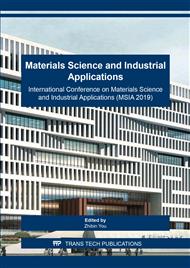[1]
M. Shirazi, A.G. Talma, J.W.M. Noordermeer, Viscoelastic properties of short aramid fibers-reinforced rubbers, Journal of Applied Polymer Science. 128 (2013) 2255-2261.
DOI: 10.1002/app.38093
Google Scholar
[2]
F. Teklal, A. Djebbar, S. Allaoui, et al, A review of analytical models to describe pull-out behavior–Fiber/matrix adhesion, Composite Structures. 201 (2018) 791-815.
DOI: 10.1016/j.compstruct.2018.06.091
Google Scholar
[3]
X. Yu, B. Gu, B. Zhang, Modeling and experimental validation of transverse compressive behavior of sepiolite reinforced rubber composites, Fibers and Polymers. 16 (2015) 2258-2265.
DOI: 10.1007/s12221-015-5212-2
Google Scholar
[4]
B. Zhang, X. Yu, B. Gu, A generalized self-consistent model for interfacial debonding behavior of fiber reinforced rubber matrix sealing composites, Journal of Shanghai Jiaotong University (Science). 22 (2017) 343-348.
DOI: 10.1007/s12204-017-1841-5
Google Scholar
[5]
B. Zhang, B. Gu, X. Yu, Prediction method for longitudinal tensile modulus of short-fiber-reinforced rubber sealing composites, Journal of Shanghai Jiaotong University. 49 (2015) 96-100.
Google Scholar
[6]
M.V. Pathan, V.L. Tagarielli, S. Patsias, Effect of fibre shape and interphase on the anisotropic viscoelastic response of fibre composites, Composite Structures. 162 (2017) 156-163.
DOI: 10.1016/j.compstruct.2016.11.046
Google Scholar
[7]
M. Romanowicz, A numerical approach for predicting the failure locus of fiber reinforced composites under combined transverse compression and axial tension, Computational Materials Science. 51 (2012) 7-12.
DOI: 10.1016/j.commatsci.2011.07.039
Google Scholar
[8]
T.J. Vaughan, C.T. McCarthy, Micromechanical modelling of the transverse damage behaviour in fibre reinforced composites, Composites Science and Technology. 71(2011) 388-396.
DOI: 10.1016/j.compscitech.2010.12.006
Google Scholar
[9]
X. Yu, B. Gu, B. Zhang, Effects of the short-fiber tip geometry and interphase properties on the interfacial debonding behavior of rubber matrix composites, Journal of Applied Polymer Science.132 (2015) 42774.
DOI: 10.1002/app.42774
Google Scholar
[10]
B. Zhang, X. Yu, B. Gu, Modeling and experimental validation of interfacial fatigue damage in fiber reinforced rubber composites, Polymer Engineering and Science. 58 (2018) 920-927.
DOI: 10.1002/pen.24646
Google Scholar
[11]
A. Pirondi, F. Moroni, Simulation of mixed-mode I/II fatigue crack propagation in adhesive joints with a modified cohesive zone model, Journal of Adhesion Science and Technology. 25 (2011) 2483-2499.
DOI: 10.1163/016942411x580180
Google Scholar
[12]
L. Shen, J. Li, Effective elastic moduli of composites reinforced by particle or fiber with an inhomogeneous interphase, International Journal of Solids and Structures. 40 (2003) 1393-1409.
DOI: 10.1016/s0020-7683(02)00659-5
Google Scholar
[13]
R. Sa, Y. Yan, Z. Wei, et al, Surface modification of aramid fibers by bio-inspired poly (dopamine) and epoxy functionalized silane grafting, ACS applied materials & interfaces. 6 (2014) 21730-21738.
DOI: 10.1021/am507087p
Google Scholar
[14]
G.C. Papanicolaou, N.K. Anifantis, L.K Keppas, et al, Stress analysis of short fiber-reinforced polymers incorporating a hybrid interphase region, Composite Interfaces. 14 (2007) 131-152.
DOI: 10.1163/156855407779819044
Google Scholar
[15]
D.S. Zhu, B.Q. Gu, Y. Chen, Micromechanical analysis of single-fiber pull out test of fiber-reinforced elastomer matrix composites, Engineering Mechanics. 26 (2009) 1-7.
DOI: 10.4028/www.scientific.net/amr.399-401.556
Google Scholar


